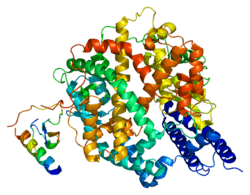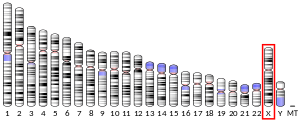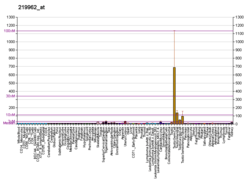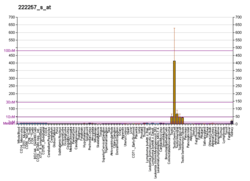Angiotensin-converting enzyme 2
Angiotensin-converting enzyme 2 (ACE2)[5] is an enzyme attached to the cell membranes of cells in the lungs, arteries, heart, kidney, and intestines.[6][7] ACE2 lowers blood pressure by catalysing the hydrolysis of angiotensin II (a vasoconstrictor peptide) into angiotensin (1–7) (a vasodilator).[8][9][10] ACE2 counters the activity of the related angiotensin-converting enzyme (ACE) by reducing the amount of angiotensin-II and increasing Ang(1-7)[11] making it a promising drug target for treating cardiovascular diseases.[12][13]
ACE2 also serves as the entry point into cells for some coronaviruses, including HCoV-NL63, SARS-CoV, and SARS-CoV-2.[5] The human version of the enzyme is often referred to as hACE2.[14]
Structure
| Angiotensin-converting enzyme 2 | |||||||||
|---|---|---|---|---|---|---|---|---|---|
| Identifiers | |||||||||
| EC number | 3.4.17.23 | ||||||||
| Databases | |||||||||
| IntEnz | IntEnz view | ||||||||
| BRENDA | BRENDA entry | ||||||||
| ExPASy | NiceZyme view | ||||||||
| KEGG | KEGG entry | ||||||||
| MetaCyc | metabolic pathway | ||||||||
| PRIAM | profile | ||||||||
| PDB structures | RCSB PDB PDBe PDBsum | ||||||||
| |||||||||
Angiotensin-converting enzyme 2 is a zinc containing metalloenzyme located on the surface of endothelial and other cells.[15] ACE2 protein contains an N-terminal peptidase M2 domain and a C-terminal collectrin renal amino acid transporter domain.[15]
ACE2 is a single-pass type I membrane protein, with its enzymatically active domain exposed on the surface of cells in lungs and other tissues.[6] The extracellular domain of ACE2 is cleaved from the transmembrane domain by another enzyme known as sheddase, and the resulting soluble protein is released into the blood stream and ultimately excreted into urine.[16][17]
Location within the body
ACE2 is present in most organs: ACE2 is attached to the cell membrane of mainly lung type II alveolar cells, enterocytes of the small intestine, arterial and venous endothelial cells and arterial smooth muscle cells in most organs. ACE2 mRNA expression is also found in the cerebral cortex, striatum, hypothalamus, and brainstem.[18] The expression of ACE2 in cortical neurons and glia make them susceptible to a SARS-CoV-2 attack, which was the possible basis of anosmia and incidences of neurological deficits seen in COVID-19.[19] As anosmia and dysgeusia are seen early in many COVID-19 patients, it was suggested to be considered to be a heralding clue in COVID-19,[20] which subsequently was declared as "significant symptoms" in COVID-19 by the American Academy of Otolaryngology–Head and Neck Surgery.[21]
Function
The primary function of ACE2 is to act as a counterbalance to Angiotensin-converting enzyme (ACE). ACE cleaves angiotensin I hormone into the vasoconstricting angiotensin II. ACE2 in turn cleaves the carboxyl-terminal amino acid phenylalanine from angiotensin II (Asp-Arg-Val-Tyr-Ile-His-Pro-Phe) and hydrolyses it into the vasodilator angiotensin (1-7), (H-Asp-Arg-Val-Tyr-Ile-His-Pro-OH).[15] ACE2 can also cleave a number of other peptides including [des-Arg9]-bradykinin, apelin, neurotensin, dynorphin A, and ghrelin.[15] ACE2 also regulates the membrane trafficking of the neutral amino acid transporter SLC6A19 and has been implicated in Hartnup's disease.[22]
Coronavirus entry point
As a transmembrane protein, ACE2 serves as the main entry point into cells for some coronaviruses, including HCoV-NL63,[5] SARS-CoV (the virus that causes SARS),[23][24][25] and SARS-CoV-2[26] (the virus that causes COVID-19).[27][28][29] More specifically, the binding of the spike S1 protein of SARS-CoV and SARS-CoV-2 to the enzymatic domain of ACE2 on the surface of cells results in endocytosis and translocation of both the virus and the enzyme into endosomes located within cells.[30][31] This entry process also requires priming of the S protein by the host serine protease TMPRSS2, the inhibition of which is under current investigation as a potential therapeutic.[32] It has also been shown that disruption of S-protein glycosylation significantly impairs viral entry, indicating an importance of glycan-protein interactions in the process.[33]
This has led some to hypothesize that decreasing the levels of ACE2, in cells, might help in fighting the infection. On the other hand, ACE2 has been shown to have a protective effect against virus-induced lung injury by increasing the production of the vasodilator angiotensin 1–7.[34] Furthermore, according to studies conducted on mice, the interaction of the spike protein of the coronavirus with ACE2 induces a drop in the levels of ACE2 in cells through internalization and degradation of the protein and hence may contribute to lung damage.[34][35]
Both ACE inhibitors and angiotensin II receptor blockers (ARBs) that are used to treat high blood pressure have been shown in rodent studies to upregulate ACE2 expression hence may affect the severity of coronavirus infections.[36][37] A systematic review and meta-analysis published on July 11, 2012, found that "use of ACE inhibitors was associated with a significant 34% reduction in risk of pneumonia compared with controls." Moreover, "the risk of pneumonia was also reduced in patients treated with ACE inhibitors who were at higher risk of pneumonia, in particular those with stroke and heart failure. Use of ACE inhibitors was also associated with a reduction in pneumonia related mortality, although the results were less robust than for overall risk of pneumonia."[38] An April 2020 study of patients hospitalized in Hubei Province in China found a death rate of 3.7% for hospitalized patients who had hypertension and were on ACE inhibitors or ARBs versus 9.8% for hospitalized patients with hypertension not on such drugs, suggesting that the drugs are not harmful and may help against the coronavirus.[39]
Despite lack of conclusive evidence, some have advocated for and others for the cessation of ACE inhibitor or ARB treatment in COVID-19 patients with hypertension.[40] However, multiple professional societies and regulatory bodies have recommended continuing standard ACE inhibitor and ARB therapy.[41][42][43]
An in vitro study focused on the early stages of infection found that clinical grade human recombinant soluble ACE2 (hrsACE2) reduced SARS-CoV-2 recovery from vero cells by a factor of 1,000-5,000.[44]
Recombinant human ACE2
Recombinant human ACE2 (rhACE2) is surmised to be a novel therapy for acute lung injury, and appeared to improve pulmonary blood flow and oxygen saturation in piglets with a lipopolysaccharide-induced acute respiratory distress syndrome.[45] The half-life of rhACE2 in human beings is about 10 hours and the onset of action is 30 minutes in addition to the course of effect (duration) of 24 hours.[45] Several findings suggest that rhACE2 may be a promising drug for those with intolerance to classic renin-angiotensin system inhibitors (RAS inhibitors) or in diseases where circulating angiotensin II is elevated.[45]
Infused rhACE2 has been evaluated in clinical trials for the treatment of acute respiratory distress syndrome.[46]
References
- GRCh38: Ensembl release 89: ENSG00000130234 - Ensembl, May 2017
- GRCm38: Ensembl release 89: ENSMUSG00000015405 - Ensembl, May 2017
- "Human PubMed Reference:". National Center for Biotechnology Information, U.S. National Library of Medicine.
- "Mouse PubMed Reference:". National Center for Biotechnology Information, U.S. National Library of Medicine.
- "Gene: ACE2, angiotensin I converting enzyme 2". National Center for Biotechnology Information (NCBI). U.S. National Library of Medicine. 2020-02-28.
- Hamming I, Timens W, Bulthuis ML, Lely AT, Navis G, van Goor H (June 2004). "Tissue distribution of ACE2 protein, the functional receptor for SARS coronavirus. A first step in understanding SARS pathogenesis". The Journal of Pathology. 203 (2): 631–7. doi:10.1002/path.1570. PMC 7167720. PMID 15141377.
- Donoghue M, Hsieh F, Baronas E, Godbout K, Gosselin M, Stagliano N, Donovan M, Woolf B, Robison K, Jeyaseelan R, Breitbart RE, and Acton S (1 Sep 2000). "A Novel Angiotensin-Converting Enzyme–Related Carboxypeptidase (ACE2) Converts Angiotensin I to Angiotensin 1-9". Circulation Research. 87 (5): e1–e9. doi:10.1161/01.RES.87.5.e1. PMID 10969042.
- Keidar S, Kaplan M, Gamliel-Lazarovich A (February 2007). "ACE2 of the heart: From angiotensin I to angiotensin (1-7)". Cardiovascular Research. 73 (3): 463–9. doi:10.1016/j.cardiores.2006.09.006. PMID 17049503.
- Wang W, McKinnie SM, Farhan M, Paul M, McDonald T, McLean B, et al. (August 2016). "Angiotensin-Converting Enzyme 2 Metabolizes and Partially Inactivates Pyr-Apelin-13 and Apelin-17: Physiological Effects in the Cardiovascular System". Hypertension. 68 (2): 365–77. doi:10.1161/HYPERTENSIONAHA.115.06892. PMID 27217402. S2CID 829514.
- Donoghue M, Hsieh F, Baronas E, Godbout K, Gosselin M, Stagliano N, et al. (September 2000). "A novel angiotensin-converting enzyme-related carboxypeptidase (ACE2) converts angiotensin I to angiotensin 1–9". Circulation Research. 87 (5): E1–9. doi:10.1161/01.res.87.5.e1. PMID 10969042.
- Chamsi-Pasha MA, Shao Z, Tang WH (March 2014). "Angiotensin-converting enzyme 2 as a therapeutic target for heart failure". Current Heart Failure Reports. Springer Science and Business Media LLC. 11 (1): 58–63. doi:10.1007/s11897-013-0178-0. PMC 3944399. PMID 24293035.
The discovery of ACE2 and its role in counteracting the effect of Ang-II through Ang(1-7) formation...An imbalance in ACE2/Ang-(1–7) and ACE/Ang-II axes is critical in the development of cardiovascular diseases. The central role of ACE2, therefore, appears to counter ACE activity by reducing Ang-II bioavailability and increasing Ang(1-7) formation...The use of RAS-modulating agents and molecules as novel therapeutic agents in hypertension and cardiovascular therapeutic research.
- Chamsi-Pasha MA, Shao Z, Tang WH (March 2014). "Angiotensin-converting enzyme 2 as a therapeutic target for heart failure". Current Heart Failure Reports. Springer Science and Business Media LLC. 11 (1): 58–63. doi:10.1007/s11897-013-0178-0. PMC 3944399. PMID 24293035.
Studies with recombinant human ACE2 (rhACE2) have shown beneficial cardiac effects [18, 36]. rhACE2 has anti-fibrotic properties and can attenuate effect on systolic and diastolic dysfunction, presumably via Ang-II inhibition .
- Mascolo A, Urbanek K, De Angelis A, Sessa M, Scavone C, Berrino L, et al. (March 2020). "Angiotensin II and angiotensin 1-7: which is their role in atrial fibrillation?". Heart Failure Reviews. Springer Science and Business Media LLC. 25 (2): 367–380. doi:10.1007/s10741-019-09837-7. PMID 31375968. S2CID 199388175.
the possibility of using the A1-7 or ACE2 analogues, to enlarge current therapeutic options for AF, may represent an important field of research.
- Kasmi Y, Khataby K, Souiri A (2019). "Coronaviridae: 100,000 Years of Emergence and Reemergence". In Ennaji MM (ed.). Emerging and Reemerging Viral Pathogens. Volume 1: Fundamental and Basic Virology Aspects of Human, Animal and Plant Pathogens. Elsevier. p. 135. ISBN 978-0-12-819400-3.
- Turner AJ (2015). "Chapter 25: ACE2 Cell Biology, Regulation, and Physiological Functions". In Unger T, Ulrike M, Steckelings UM, dos Santos RA (eds.). The Protective Arm of the Renin Angiotensin System (RAS): Functional Aspects and Therapeutic Implications. Academic Press. pp. 185–189. doi:10.1016/B978-0-12-801364-9.00025-0. ISBN 978-0-12-801364-9. S2CID 88645177.
- Lambert DW, Yarski M, Warner FJ, Thornhill P, Parkin ET, Smith AI, et al. (August 2005). "Tumor necrosis factor-alpha convertase (ADAM17) mediates regulated ectodomain shedding of the severe-acute respiratory syndrome-coronavirus (SARS-CoV) receptor, angiotensin-converting enzyme-2 (ACE2)". The Journal of Biological Chemistry. 280 (34): 30113–9. doi:10.1074/jbc.M505111200. PMID 15983030.
- Patel VB, Clarke N, Wang Z, Fan D, Parajuli N, Basu R, et al. (January 2014). "Angiotensin II induced proteolytic cleavage of myocardial ACE2 is mediated by TACE/ADAM-17: a positive feedback mechanism in the RAS". Journal of Molecular and Cellular Cardiology. 66: 167–76. doi:10.1016/j.yjmcc.2013.11.017. PMID 24332999.
- Kabbani, Nadine; Olds, James L (1 April 2020). "Does COVID19 infect the brain? If so, smokers might be at a higher risk". Molecular Pharmacology. 97 (5): 351–353. doi:10.1124/molpharm.120.000014. PMC 7237865. PMID 32238438.
- Baig AM. Neurological manifestations in COVID-19 caused by SARS-CoV-2. CNS Neurosci Ther. 2020;26(5):499–501. doi:10.1111/cns.13372
- Baig AM, Khaleeq A, Ali U, Syeda H. Evidence of the COVID-19 Virus Targeting the CNS: Tissue Distribution, Host-Virus Interaction, and Proposed Neurotropic Mechanisms. ACS Chem Neurosci. 2020;11(7):995–998. doi:10.1021/acschemneuro.0c00122
- "Coronavirus Disease 2019: Resources | American Academy of Otolaryngology-Head and Neck Surgery". Entnet.org. Retrieved 2020-05-04.
- Kuba K, Imai Y, Penninger JM (2013). "Multiple functions of angiotensin-converting enzyme 2 and its relevance in cardiovascular diseases". Circulation Journal. 77 (2): 301–8. doi:10.1253/circj.cj-12-1544. PMID 23328447.
- Fehr AR, Perlman S (2015). "Coronaviruses: an overview of their replication and pathogenesis". Coronaviruses. Methods in Molecular Biology. 1282. Springer New York. pp. 1–23. doi:10.1007/978-1-4939-2438-7_1. ISBN 978-1-4939-2437-0. PMC 4369385. PMID 25720466.
Many α-coronaviruses utilize aminopeptidase N (APN) as their receptor, SARS-CoV and HCoV-NL63 use angiotensin-converting enzyme 2 (ACE2) as their receptor, MHV enters through CEACAM1, and the recently identified MERS-CoV binds to dipeptidyl-peptidase 4 (DPP4) to gain entry into human cells (See Table 1 for a list of known CoV receptors).
- Li F (October 2013). "Receptor recognition and cross-species infections of SARS coronavirus". Antiviral Research. 100 (1): 246–54. doi:10.1016/j.antiviral.2013.08.014. PMC 3840050. PMID 23994189.
- Kuba K, Imai Y, Rao S, Gao H, Guo F, Guan B, et al. (August 2005). "A crucial role of angiotensin converting enzyme 2 (ACE2) in SARS coronavirus-induced lung injury". Nature Medicine. 11 (8): 875–9. doi:10.1038/nm1267. PMC 7095783. PMID 16007097.
- "What are the official names of the disease and the virus that causes it?". Q&A on coronaviruses. World Health Organization. Archived from the original on 5 March 2020. Retrieved 22 February 2020.
- Zhou P, Yang XL, Wang XG, Hu B, Zhang L, Zhang W, et al. (March 2020). "A pneumonia outbreak associated with a new coronavirus of probable bat origin". Nature. 579 (7798): 270–273. Bibcode:2020Natur.579..270Z. doi:10.1038/s41586-020-2012-7. PMC 7095418. PMID 32015507.
- Xu X, Chen P, Wang J, Feng J, Zhou H, Li X, et al. (March 2020). "Evolution of the novel coronavirus from the ongoing Wuhan outbreak and modeling of its spike protein for risk of human transmission". Science China. Life Sciences. 63 (3): 457–460. doi:10.1007/s11427-020-1637-5. PMC 7089049. PMID 32009228.
- Lewis R (2020-02-20). "COVID-19 Vaccine Will Close in on the Spikes". DNA Science Blog. Public Library of Science. Archived from the original on 2020-02-22. Retrieved 2020-02-22.
- Wang H, Yang P, Liu K, Guo F, Zhang Y, Zhang G, Jiang C (February 2008). "SARS coronavirus entry into host cells through a novel clathrin- and caveolae-independent endocytic pathway". Cell Research. 18 (2): 290–301. doi:10.1038/cr.2008.15. PMC 7091891. PMID 18227861.
- Millet JK, Whittaker GR (April 2018). "Physiological and molecular triggers for SARS-CoV membrane fusion and entry into host cells". Virology. 517: 3–8. doi:10.1016/j.virol.2017.12.015. PMC 7112017. PMID 29275820.
- Akhmerov Akbarshakh; Marban Eduardo (2020). "COVID-19 and the Heart". Circulation Research. 0 (10): 1443–1455. doi:10.1161/CIRCRESAHA.120.317055. PMC 7188058. PMID 32252591.
- Novokmet M, Baković MP, Lauc G (1 April 2020). "Understanding Glycans in COVID-19 Drug Design". Genetic Engineering and Biotechnology News. Retrieved 2020-05-18.
- Imai Y, Kuba K, Penninger JM (May 2008). "The discovery of angiotensin-converting enzyme 2 and its role in acute lung injury in mice". Experimental Physiology. 93 (5): 543–8. doi:10.1113/expphysiol.2007.040048. PMC 7197898. PMID 18448662.
- Jia H (September 2016). "Pulmonary Angiotensin-Converting Enzyme 2 (ACE2) and Inflammatory Lung Disease". Shock. Augusta, Ga. 46 (3): 239–48. doi:10.1097/SHK.0000000000000633. PMID 27082314. S2CID 3639219.
Once SARS-CoV binds to its receptor, the abundance on the cell surface, mRNA expression and the enzymatic activity of ACE2 are significantly reduced. ... These effects are, in part, due to enhanced shedding/internalizing processes. ... The spike protein binds to ACE2 and subsequently down regulated ACE2 protein expression and resulted in worsened acid aspiration pneumonia
- Nicholls J, Peiris M (August 2005). "Good ACE, bad ACE do battle in lung injury, SARS". Nature Medicine. 11 (8): 821–2. doi:10.1038/nm0805-821. PMC 7095949. PMID 16079870.
- Diaz JH (March 2020). "Hypothesis: angiotensin-converting enzyme inhibitors and angiotensin receptor blockers may increase the risk of severe COVID-19". Journal of Travel Medicine. 27 (3). doi:10.1093/jtm/taaa041. PMC 7184445. PMID 32186711.
- Caldeira D, Alarcão J, Vaz-Carneiro A, Costa J (July 2012). "Risk of pneumonia associated with use of angiotensin converting enzyme inhibitors and angiotensin receptor blockers: systematic review and meta-analysis". BMJ. 345 (jul11 1): e4260. doi:10.1136/bmj.e4260. PMC 3394697. PMID 22786934.
Our results suggest an important role of ACE inhibitors, but not ARBs, in reducing the risk of pneumonia. These data may discourage the withdrawal of ACE inhibitors in some patients with tolerable adverse events (namely, cough) who are at particularly high risk of pneumonia. ACE inhibitors also lowered the risk of pneumonia related mortality, mainly in patients with established disease, but the robustness of the evidence was weaker.
- Zhanf P, Zhu L, Cai J, et al. (April 2020). "Association of Inpatient Use of Angiotensin Converting Enzyme Inhibitors and Angiotensin II Receptor Blockers with Mortality Among Patients With Hypertension Hospitalized With COVID-19". Circ Res. 126 (12): 1671–1681. doi:10.1161/CIRCRESAHA.120.317134. PMC 7265882. PMID 32302265.
- Patel AB, Verma A (March 2020). "COVID-19 and Angiotensin-Converting Enzyme Inhibitors and Angiotensin Receptor Blockers: What Is the Evidence?". JAMA. doi:10.1001/jama.2020.4812. PMID 32208485.
- "Position Statement of the ESC Council on Hypertension on ACE-Inhibitors and Angiotensin Receptor Blockers". European Society of Cardiology (ESC). 13 March 2020. Lay summary – Medscape.
- "EMA advises continued use of medicines for hypertension, heart or kidney disease during COVID-19 pandemic". European Medicines Agency (EMA). 27 March 2020. Lay summary – Medscape.
- "HFSA/ACC/AHA Statement Addresses Concerns Re: Using RAAS Antagonists in COVID-19". American College of Cardiology (ACC). 27 March 2020. Lay summary – Medscape.
- Monteil V, Kwon H, Prado P, Hagelkrüys A, Wimmer RA, Stahl M, et al. (April 2020). "Inhibition of SARS-CoV-2 Infections in Engineered Human Tissues Using Clinical-Grade Soluble Human ACE2". Cell. 181 (4): 905–913.e7. doi:10.1016/j.cell.2020.04.004. PMC 7181998. PMID 32333836.
- Colafella KM, Uijl E, Danser J (2019). "Interference With the Renin–Angiotensin System (RAS): Classical Inhibitors and Novel Approaches". Encyclopedia of Endocrine Diseases. Elsevier. pp. 523–530. doi:10.1016/b978-0-12-801238-3.65341-2. ISBN 978-0-12-812200-6.
- Khan A, Benthin C, Zeno B, Albertson TE, Boyd J, Christie JD, et al. (September 2017). "A pilot clinical trial of recombinant human angiotensin-converting enzyme 2 in acute respiratory distress syndrome". Critical Care. 21 (1): 234. doi:10.1186/s13054-017-1823-x. PMC 5588692. PMID 28877748.
External links
- Human ACE2 genome location and ACE2 gene details page in the UCSC Genome Browser.
- Angiotensin-converting enzyme 2 in Membranome database
- 3D structure of complex of a neurotransmitter sodium symporter B(0)AT1, ACE2, and SARS-CoV-2 receptor-binding domain in OPM database
- Overview of all the structural information available in the PDB for UniProt: Q9BYF1 (Angiotensin-converting enzyme 2) at the PDBe-KB.






